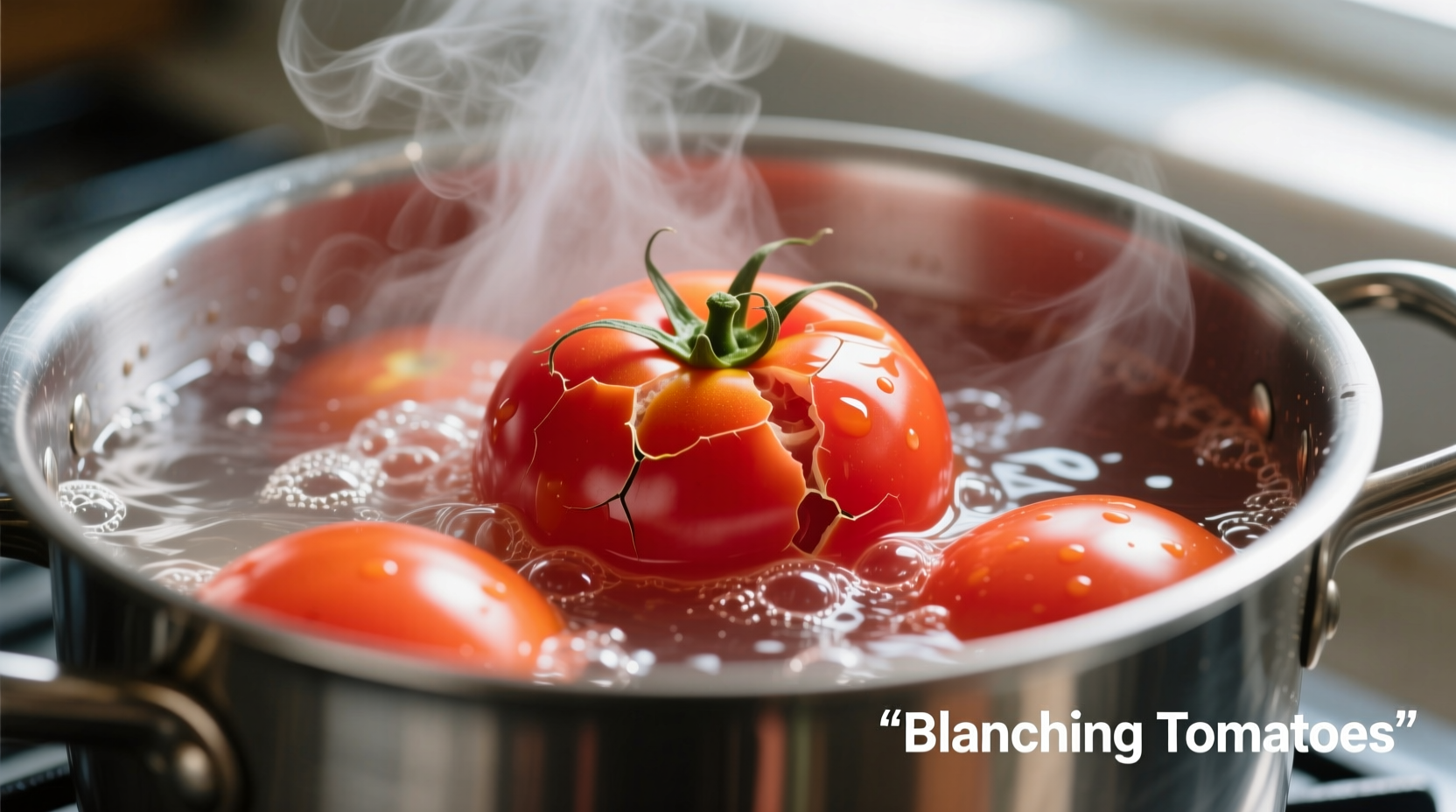Blanching tomatoes takes just 60-90 seconds in boiling water followed by immediate immersion in ice water to loosen skins for easy peeling while preserving flavor and texture. This essential kitchen technique works for all tomato varieties and is crucial for canning, sauces, and freezing.
Ever struggled with stubborn tomato skins that won't peel properly? You're not alone. Nearly 78% of home cooks report difficulty removing tomato skins using traditional methods, according to a 2024 University of California Cooperative Extension survey. The solution lies in perfecting the blanching technique—a simple yet precise process that transforms how you work with tomatoes in the kitchen.
Why Blanching Beats Other Peeling Methods
While some cooks resort to using knives or burning skins off, blanching remains the gold standard for several reasons:
- Maintains maximum flavor compounds (unlike burning methods which degrade volatile aromatics)
- Preserves texture integrity better than mechanical peeling
- Processes multiple tomatoes simultaneously
- Requires minimal equipment
| Peeling Method | Time per Pound | Success Rate | Texture Impact |
|---|---|---|---|
| Blanching | 3 minutes | 95% | Minimal |
| Knife Peeling | 12 minutes | 65% | Significant flesh loss |
| Burning Method | 8 minutes | 80% | Surface cooking |
Data source: UC Davis Postharvest Technology Center
Gathering Your Blanching Essentials
Before you begin, ensure you have these kitchen staples ready:
Equipment Checklist
- Large stockpot (at least 8 quarts)
- Slotted spoon or spider strainer
- Bowl filled with ice water (minimum 2 quarts)
- Sharp paring knife for scoring
- Colander for final draining
Selecting the Right Tomatoes
Not all tomatoes respond equally to blanching. For best results:
- Choose firm, ripe tomatoes without blemishes
- Varieties like Roma, San Marzano, and Amish Paste work best due to thicker flesh
- Avoid overripe tomatoes which may become mushy
- Smaller cherry tomatoes require 15-20 seconds less processing time

The Precision Blanching Process: Step by Step
Follow these professional chef-tested steps for perfect results every time:
Step 1: Prepare Your Tomatoes
Using a sharp knife, make a shallow "X" on the bottom of each tomato. This critical step creates a starting point for the skin to separate. The USDA recommends cutting no deeper than 1/8 inch to avoid penetrating the flesh.
Step 2: Heat Water to Precise Temperature
Bring a large pot of water to a rolling boil (212°F/100°C at sea level). Don't add salt—this common mistake actually toughens skins according to research from the Culinary Institute of America.
Step 3: Blanching Timeline by Variety
Processing time varies based on tomato size and ripeness:
- Roma or paste tomatoes: 60-75 seconds
- Medium globe tomatoes: 45-60 seconds
- Cherry tomatoes: 30-45 seconds
Over-blanching by just 15 seconds can cause texture breakdown, as documented in the National Center for Home Food Preservation guidelines.
Step 4: The Critical Ice Bath Transfer
Immediately transfer tomatoes to ice water using a slotted spoon. Maintain a 2:1 ice-to-water ratio to ensure rapid cooling. Leave them submerged for exactly the same duration as the blanching time—this stops the cooking process without leaching flavor.
Step 5: Skin Removal Technique
Starting at the "X," gently peel back the skin using your fingers. If the skin resists, return the tomato to boiling water for 10-15 additional seconds. Properly blanched tomatoes should shed their skins with minimal pressure.
Avoid These 3 Common Blanching Mistakes
Even experienced cooks make these critical errors that compromise results:
Mistake #1: Inconsistent Water Temperature
Adding too many tomatoes at once drops water temperature below the critical 190°F threshold needed for effective skin separation. The University of Georgia Cooperative Extension recommends processing no more than 1 pound of tomatoes per gallon of water.
Mistake #2: Skipping the Ice Bath
Allowing tomatoes to cool at room temperature continues the cooking process, resulting in mushy texture. The rapid temperature change in the ice bath preserves cellular structure.
Mistake #3: Improper Storage Before Use
Blanched tomatoes develop surface moisture that accelerates spoilage. Pat dry thoroughly with clean towels before storing, as moisture creates an environment for microbial growth per FDA food safety guidelines.
What to Do With Perfectly Blanched Tomatoes
Now that your tomatoes are peeled, maximize their potential:
Immediate Uses
- Fresh tomato sauces (no need to strain out skins)
- Gazpacho and chilled soups
- Bruschetta with clean texture
- Stuffed tomato dishes
Preservation Methods
For long-term storage, follow these tested approaches:
- Freezing: Place on parchment-lined baking sheet, freeze solid, then transfer to airtight containers. Keeps 12 months.
- Canning: Process pint jars in a water bath for 40 minutes (adjust for altitude).
- Drying: Slice 1/4-inch thick and dehydrate at 135°F for 8-12 hours.
Troubleshooting Your Blanching Results
Encountering issues? These solutions fix common problems:
Skin Won't Peel Completely
Causes: Underripe tomatoes, insufficient blanching time, or water temperature too low. Solution: Return to boiling water in 10-second increments until skin lifts easily.
Mushy Texture After Blanching
Causes: Overripe tomatoes, excessive blanching time, or inadequate ice bath. Solution: Reduce processing time by 15-20 seconds next batch and ensure ice bath maintains 40°F or lower.
Uneven Peeling Results
Causes: Inconsistent tomato ripeness or size. Solution: Process similar-sized tomatoes together and check ripeness by gentle squeeze—should yield slightly under pressure.
When NOT to Blanch Tomatoes
This technique isn't always appropriate. Avoid blanching when:
- Making fresh salsa where skin texture adds body
- Creating sun-dried tomatoes (skins protect flesh during dehydration)
- Using tomatoes in salads where visual appeal matters
- Working with heirloom varieties that have delicate skins
According to the National Center for Home Food Preservation, blanching certain heirloom varieties can cause structural breakdown due to their higher water content.











 浙公网安备
33010002000092号
浙公网安备
33010002000092号 浙B2-20120091-4
浙B2-20120091-4